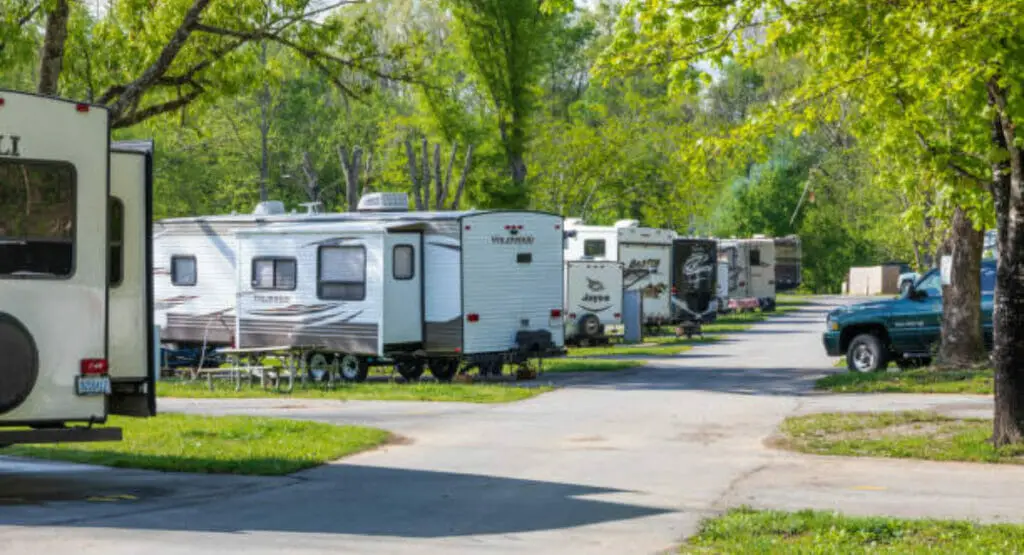RV adventures are all about freedom and flexibility, but nothing spoils the fun like an uneven parking spot. Enter RV leveling blocks, the unsung heroes of smooth, stable camping experiences. In this guide, we’ll delve into everything you need to know about leveling blocks for your RV, ensuring your next trip is hassle-free and comfortable.
I. Understanding RV Leveling Blocks:
1. What are RV Leveling Blocks?
RV leveling blocks are essential tools for ensuring that your recreational vehicle (RV) remains stable and level when parked on uneven terrain. They are typically rectangular or wedge-shaped blocks designed to support the wheels of your RV, allowing you to adjust the height of each wheel independently to achieve a level surface.
2. How Do They Work?
RV leveling blocks work by elevating the low side of your RV to match the height of the high side, effectively leveling the vehicle. By placing the blocks under the wheels on one side of the RV, you can gradually raise or lower that side until it is parallel to the ground. This ensures that the RV remains stable and all systems function correctly.
3. Types of Leveling Blocks Available
a. Plastic Leveling Blocks
PROS:
- Lightweight and Easy to Transport: These blocks are convenient to carry and handle.
- Stackable Design for Adjustable Height: They can be easily stacked to achieve the desired height.
- Resistant to Water and Corrosion: Ideal for outdoor use in various weather conditions.
CONS:
- Less Durable than Wood or Metal Blocks: They may not last as long under heavy use.
- Limited Weight Capacity: Not suitable for very heavy RVs.
b. Wood Leveling Blocks
PROS:
- Durable and Sturdy Construction: Provide excellent support for heavy RVs.
- Customizable: Can be cut or shaped to fit specific needs.
CONS:
- Heavier and Bulkier: More challenging to transport and store.
- Requires More Effort to Stack and Adjust: Not as easy to use as plastic blocks.
c. Metal Leveling Blocks
PROS:
- Exceptionally Durable and Long-Lasting: Can withstand heavy loads without bending.
- High Weight Capacity: Suitable for the heaviest RVs.
CONS:
- Heavier and More Expensive: Less convenient to transport and more costly.
- Limited Availability: Not as commonly found as plastic or wood blocks.
II. Importance of Leveling Your RV
1. Why is Leveling Necessary?
1. Operational Efficiency of Appliances: Many RV appliances, such as refrigerators, are designed to function optimally when the RV is level. These appliances often rely on gravity for their cooling systems to work correctly. Operating them on an uneven surface can lead to inefficient performance and potential damage.
2. Comfort and Stability: A level RV ensures a stable and comfortable living environment. An uneven RV can cause doors to swing open or closed unexpectedly, create an uncomfortable sleeping surface, and make walking around inside the RV awkward and potentially hazardous.
3. Effective Water Drainage: Proper leveling is essential for the RV’s plumbing system to work correctly. If the RV is not level, water may not drain properly from sinks, showers, and tanks, leading to clogs, leaks, or water damage.
2. Risks of Parking on Uneven Ground
1. Structural Stress: Parking on an uneven surface can place undue stress on the RV’s frame and chassis. Over time, this stress can cause structural issues, leading to costly repairs.
2. Appliance Damage: As mentioned, many RV appliances require a level surface to operate correctly. Using these appliances while the RV is uneven can result in malfunctions or permanent damage.
3. Comfort Issues: Sleeping, cooking, and other activities can become uncomfortable and inconvenient. This can significantly detract from the enjoyment of your RV experience.
3. Impact on Comfort and Safety
1. Sleeping Arrangements: An unlevel RV can make sleeping uncomfortable. Beds that are not level can cause sleepers to slide or feel uneven pressure, leading to a poor night’s sleep and fatigue.
2. Mobility Inside the RV: Moving around inside an uneven RV can be tricky. Slopes can cause you to lose your footing, potentially leading to falls and injuries.
3. Functional Use of Facilities: Activities like cooking, using the bathroom, or even sitting at a table become more difficult and less enjoyable when the RV is not level. This impacts the overall quality of your RV experience.
3. Preventing Damage to Your RV’s Systems
1. Plumbing: Proper leveling ensures that water flows correctly through the RV’s plumbing system, preventing blockages and potential damage to pipes and tanks.
2. Refrigeration: Many RV refrigerators use ammonia absorption systems that require a level surface to function correctly. Running these systems on an uneven surface can cause the coolant to settle improperly, leading to cooling inefficiency or damage.
3. Structural Integrity: Continuous parking on uneven surfaces can lead to frame warping or damage to the RV’s support structures. Leveling helps distribute weight evenly, reducing stress on the RV’s framework.
III. Choosing the Right Leveling Blocks
1. Factors to Consider
1. Weight Capacity: Ensure the leveling blocks can support the weight of your RV. Heavier RVs will need blocks with higher weight capacities.
2. Durability: Consider the material and build quality. Durable blocks made from high-quality materials will last longer and provide better support.
3. Ease of Use: Look for blocks that are easy to handle, stack, and store. User-friendly designs will save time and effort during setup and takedown.
2. Assessing Your RV’s Leveling Needs
Before purchasing leveling blocks, assess your RV’s specific needs. Consider the weight of your RV, the type of terrain you typically encounter, and how often you’ll need to level your RV. This assessment will help you choose the most suitable leveling blocks.
3. Reviews of Popular Leveling Block Brands
1. Camco: Known for its durable, interlocking plastic blocks that are easy to use and store.
2. Tri-Lynx: Offers a versatile, modular design that can be configured in various ways to achieve the desired height.
3. Andersen: Provides curved leveling blocks that offer a simple, one-step leveling process, ideal for quick adjustments.
III. How to Use RV Leveling Blocks
1. Step-by-Step Guide to Leveling Your RV Using Blocks
1. Assess the Ground: Identify the low side of your RV and determine how much you need to raise it to be level.
2. Place the Blocks: Position the leveling blocks in front of or behind the wheels on the low side of the RV.
3. Drive onto the Blocks: Slowly drive the RV onto the blocks until it is level. Use a level tool to check for accuracy.
4. Secure the RV: Once level, engage the parking brake and place chocks under the wheels to prevent movement.
2. Tips for Finding the Best Placement
1. Use a Level Tool: A bubble level or smartphone app can help you determine the exact level of your RV.
2. Adjust Gradually: Make small adjustments to avoid overcorrecting and making the RV uneven in the opposite direction.
3. Consider Terrain: On soft ground, place a larger, flat board under the leveling blocks to prevent sinking.
3. Ensuring Stability and Safety
1. Use Chock Blocks: Place chocks under the wheels to prevent the RV from rolling.
2. Double-Check: After leveling, double-check the RV’s stability before setting up camp.
3. Regular Inspections: Periodically inspect the leveling blocks and chocks during your stay to ensure they remain in place.
4. Video Tutorials for Visual Learners
For visual learners, numerous video tutorials are available online that provide step-by-step instructions and demonstrations on how to use RV leveling blocks effectively.
IV. Maintenance and Care Tips
1. Cleaning and Storing Your Leveling Blocks
1. Clean After Use: Remove dirt and debris from the blocks after each use to prevent buildup.
2. Dry Thoroughly: Ensure the blocks are dry before storing to prevent mold and mildew, especially for wooden blocks.
3. Store Properly: Keep the blocks in a dry, protected area to extend their lifespan.
2. Inspecting for Damage or Wear
1. Regular Inspections: Check the blocks for cracks, chips, or other signs of wear and tear.
2. Replace as Needed: Replace any damaged blocks to ensure safe and effective leveling.
3. Extending the Lifespan of Your Blocks
1. Avoid Overloading: Do not exceed the weight capacity of the blocks.
2. Use on Suitable Surfaces: Use the blocks on stable, flat surfaces whenever possible to prevent unnecessary stress.
V. Alternative Leveling Methods
1. Hydraulic Leveling Systems
Hydraulic leveling systems offer a convenient, automatic solution for leveling your RV. These systems use hydraulic jacks to adjust the RV’s height at the push of a button.
Pros:
- Ease of Use: Automated leveling with minimal effort.
- Precision: Provides precise leveling adjustments.
Cons:
- Cost: More expensive than manual leveling blocks.
- Maintenance: Requires regular maintenance and potential repairs.
2. DIY Leveling Solutions
For those who prefer a hands-on approach, DIY leveling solutions using materials like wood planks can be an effective alternative.
Pros:
- Customizable: Tailor-made to fit your specific needs.
- Cost-Effective: Often cheaper than commercial leveling blocks.
Cons:
- Labor-Intensive: Requires more effort to create and use.
- Less Durable: May not last as long as purpose-built leveling blocks.
VI. RV Leveling Block Accessories
1. Chock Blocks for Added Stability
Chock blocks are placed under the wheels to prevent the RV from rolling once it is level. They provide an extra layer of safety and stability.
2. Storage Solutions for Keeping Blocks Organized
Invest in storage bags or containers to keep your leveling blocks organized and easy to access.
3. Innovative Leveling Gadgets and Tools
Consider additional tools like leveling ramps, digital levels, and bubble levels to enhance your leveling process.
VII. Real-Life RVers’ Experiences
1. Stories and Testimonials from Seasoned Travelers
Experienced RVers often have valuable insights and stories about their leveling experiences. These can provide practical tips and inspire confidence in new RVers.
2. Lessons Learned and Valuable Tips
1. Plan Ahead: Research your campsite beforehand to anticipate leveling needs.
2. Practice Makes Perfect: The more you level your RV, the easier and quicker it becomes.
3. Stay Flexible: Be prepared to adjust your setup as needed to achieve the best results.
Conclusion
Investing in quality leveling blocks is crucial for a smooth and enjoyable RVing experience. Proper leveling enhances comfort, safety, and the longevity of your RV’s systems. By mastering the art of RV leveling blocks, you’ll unlock a new level of comfort and convenience on your travels. Whether you’re a newbie RVer or a seasoned road warrior, these essential tools are your ticket to smooth sailing, wherever the open road may take you. Final tips for stress-free camping adventures include always carrying extra blocks, practicing your leveling skills, and regularly inspecting your blocks for wear and tear. With the right preparation and equipment, you can ensure a stable, comfortable, and enjoyable RV experience every time.



